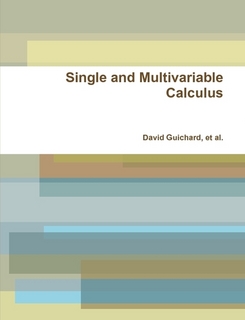
Community Calculus

An early transcendentals book covering single variable calculus, infinite series, and multivariable calculus.
License: Creative Commons Attribution Sharealike Noncommercial. This license is very open. It allows reuse, remixing, and distribution, but prohibits commercial use and requires any remixes use the same license as the original. This limits where the content can be remixed into, but on the other hand ensures that no-one can remix the content then put the remix under a more restrictive license. The non-commercial clause can make getting printed copies of remixes challenging depending upon how strictly the authors interpret the clause.
Formats:
- PDF. A Portable Document Format (PDF) file is can be opened using the free Acrobat Reader. It is not an editable format.
- TeX. A TeX file use the TeX or LaTeX typesetting engine. TeX software is available free for most platforms. It is an editable format
Openness Rating (0-4): 3
- Chapter 1 Analytic Geometry
- 1.1 Lines
- 1.2 Distance Between Two Points; Circles
- 1.3 Functions
- 1.4 Shifts and Dilations
- Chapter 2 Instantaneous Rate of Change: The Derivative
- 2.1 The slope of a function
- 2.2 An example
- 2.3 Limits
- 2.4 The Derivative Function
- 2.5 Adjectives For Functions
- Chapter 3 Rules for Finding Derivatives
- 3.1 The Power Rule
- 3.2 Linearity of the Derivative
- 3.3 The Product Rule
- 3.4 The Quotient Rule
- 3.5 The Chain Rule
- Chapter 4 Transcendental Functions
- 4.1 Trigonometric Functions
- 4.2 The Derivative of sin x
- 4.3 A hard limit
- 4.4 The Derivative of sin x, continued
- 4.5 Derivatives of the Trigonometric Functions
- 4.6 Exponential and Logarithmic functions
- 4.7 Derivatives of the exponential and logarithmic functions
- 4.8 Limits revisited
- 4.9 Implicit Differentiation
- 4.10 Inverse Trigonometric Functions
- 4.11 Hyperbolic Functions
- Chapter 5 Curve Sketching
- 5.1 Maxima and Minima
- 5.2 The first derivative test
- 5.3 The second derivative test
- 5.4 Concavity and inflection points
- 5.5 Asymptotes and Other Things to Look For
- Chapter 6 Applications of the Derivative
- 6.1 Optimization
- 6.2 Related Rates
- 6.3 Newton’s Method
- 6.4 Linear Approximations
- 6.5 The Mean Value Theorem
- Chapter 7 Integration
- 7.1 Two examples
- 7.2 The Fundamental Theorem of Calculus
- 7.3 Some Properties of Integrals
- Chapter 8 Techniques of Integration
- 8.1 Substitution
- 8.2 Powers of sine and cosine
- 8.3 Trigonometric Substitutions
- 8.4 Integration by Parts
- 8.5 Rational Functions
- 8.6 Numerical Integration
- 8.7 Additional exercises
- Chapter 9 Applications of Integration
- 9.1 Area between curves
- 9.2 Distance, Velocity, Acceleration
- 9.3 Volume
- 9.4 Average value of a function
- 9.5 Work
- 9.6 Center of Mass
- 9.7 Kinetic energy; improper integrals
- 9.8 Probability
- 9.9 Arc Length
- 9.10 Surface Area
- Chapter 10 Polar Coordinates, Parametric Equations
- 10.1 Polar Coordinates
- 10.2 Slopes in polar coordinates
- 10.3 Areas in polar coordinates
- 10.4 Parametric Equations
- 10.5 Calculus with Parametric Equations
- Chapter 11 Sequences and Series
- 11.1 Sequences
- 11.2 Series
- 11.3 The Integral Test
- 11.4 Alternating Series
- 11.5 Comparison Tests
- 11.6 Absolute Convergence
- 11.7 The Ratio and Root Tests
- 11.8 Power Series
- 11.9 Calculus with Power Series
- 11.10 Taylor Series
- 11.11 Taylor’s Theorem
- 11.12 Additional exercises
- Chapter 12 Three Dimensions
- 12.1 The Coordinate System
- 12.2 Vectors
- 12.3 The Dot Product
- 12.4 The Cross Product
- 12.5 Lines and Planes
- 12.6 Other Coordinate Systems
- Chapter 13 Vector Functions
- 13.1 Space Curves
- 13.2 Calculus with vector functions
- 13.3 Arc length
- 13.4 Motion along a curve
- Chapter 14 Partial Differentiation
- 14.1 Functions of Several Variables
- 14.2 Limits and Continuity
- 14.3 Partial Differentiation
- 14.4 The Chain Rule
- 14.5 Directional Derivatives
- 14.6 Higher order derivatives
- 14.7 Maxima and minima
- 14.8 Lagrange Multipliers
- Chapter 15 Multiple Integration
- 15.1 Volume and Average Height
- 15.2 Double Integrals in Cylindrical Coordinates
- 15.3 Moment and Center of Mass
- 15.4 Surface Area
- 15.5 Triple Integrals
- 15.6 Cylindrical and Spherical Coordinates
- 15.7 Change of Variables
- Chapter 16 Vector Calculus
- 16.1 Vector Fields
- 16.2 Line Integrals
- 16.3 The Fundamental Theorem of Line Integrals
- 16.4 Green’s Theorem
- 16.5 Divergence and Curl
- 16.6 Vector Equations of Surfaces
- 16.7 Surface Integrals
- 16.8 Stokes’s Theorem
- 16.9 The Divergence Theorem
Supplements: None